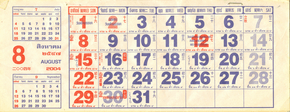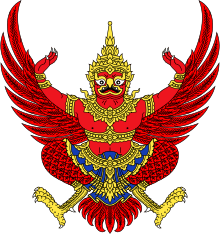Thai solar calendar

The Thai solar calendar (Thai: ปฏิทินสุริยคติ, RTGS: patithin suriyakhati, "solar calendar") was adopted by King Chulalongkorn (Rama V) in AD 1888 as the Siamese version of the Gregorian calendar, replacing the Thai lunar calendar as the legal calendar in Thailand (though the latter is still also used, especially for traditional and religious events). Years are now counted in the Buddhist Era (B.E.): พุทธศักราช, พ.ศ., (RTGS: Phutthasakkarat) which is 543 years ahead of the Christian/Common Era.
Years
The Siamese generally used two calendars, a sacred and a popular (vulgar in the classical sense). The vulgar or minor era (จุลศักราช, chula sakarat) was thought to have been instituted when the worship of Gautama was first introduced,[1] [2] and corresponds to the traditional Burmese calendar (abbreviated ME or BE, the latter not to be confused with the abbreviation for the Buddhist Era, which is the sacred era.)
Rattanakosin Era
King Chulalongkorn decreed a change in vulgar reckoning to the Rattanakosin Era (รัตนโกสินทรศก, Rattanakosin Sok abbreviated ร.ศ. and R.S.) in 1889 CE. The epoch (reference date) for Year 1 was 6 April 1782 with the accession of Rama I, the foundation of the Chakri Dynasty, and the founding of Bangkok (Rattanakosin) as capital. To convert years in R.S. to the Common Era, add 1781 for dates from April to December, and 1782 for dates from January to March.
Buddhist Era
In Thailand the sacred, or Buddhist Era, is reckoned to have an epochal year 0 from 11 March 543 BC, believed to be the date of the death of Gautama Buddha. King Vajiravudh (Rama VI) changed year counting to this Buddhist Era (abbreviated BE) and moved the start of the year back to 1 April in 2455 BE, AD 1912. As there is no longer any reference to a vulgar or popular era, the Common Era may be presumed to have taken the place of the former.
New year
New Year, the time at which a new calendar year begins and the calendar's year count is incremented, originally coincided with the date calculated for Songkran, when the Sun transits the constellation of Aries, the first astrological sign in the Zodiac as reckoned by sidereal astrology: thus the year commenced on 11 April 1822.[1] As previously noted, Rama VI moved the start of the year back to 1 April in 2455 BE, AD 1912.
On 6 September 1940, Prime Minister Phibunsongkhram decreed[3] 1 January 1941 as the start of the year 2484 BE, so year 2483 BE had only nine months. To convert dates from 1 January to 31 March prior to that year, the number to add or subtract is 542; otherwise, it is 543. Example:
| Month | 1–3 | 4–6 | 7–9 | 10–12 | 1–3 | 4–6 | 7–9 | 10–12 | 1–3 | 4–6 | 7–9 | 10–12 | 1–3 | 4–6 | 7–9 | 10–12 |
|---|---|---|---|---|---|---|---|---|---|---|---|---|---|---|---|---|
| AD | 1939 | 1940 | 1941 | 1942 | ||||||||||||
| BE | 2481 | 2482 | 2483 | 2484 | 2485 | |||||||||||
| Thai Month | 10-12 | 1-3 | 4–6 | 7–9 | 10-12 | 1-3 | 4–6 | 7–9 | 1-3 | 4-6 | 7-9 | 10-12 | 1-3 | 4-6 | 7-9 | 10-12 |
Today, both the Common Era New Year's Day (1 January) and the traditional Thai New Year (สงกรานต์, Songkran) celebrations (13–15 April) are public holidays in Thailand. In the traditional Thai calendar, the change to the next Chinese zodiacal animal occurs at Songkran (now fixed at 13 April.)[4] For Thai Chinese communities in Thailand, however, the Chinese calendar determines the day that a Chinese New Year begins, and assumes the name of the next animal in the twelve-year animal cycle.
Months
Names of the months derive from Hindu astrology names for the signs of the zodiac. Thirty-day-month names end in -ayon (-ายน), from Sanskrit root āyana : the arrival of; 31-day-month names end in -akhom (-าคม), from Sanskrit āgama (cognate to English "come") that also means the arrival of.
February's name ends in -phan (-พันธ์), from Sanskrit bandha : "fettered" or "bound". The day added to February in a solar leap year is Athikasuratin (อธิกสุรทิน, respelled to aid pronunciation (อะทิกะสุระทิน) from Sanskrit adhika : additional; sura : move).[5]
| English name | Thai name | Abbr. | Thai Pronunciation | Sanskrit word | Zodiac sign |
|---|---|---|---|---|---|
| January | มกราคม | ม.ค. | mákàraa-khom, mókkàraa-khom | makara "sea-monster" | Capricorn |
| February | กุมภาพันธ์ | ก.พ. | kumphaa-phan | kumbha "pitcher, water-pot" | Aquarius |
| March | มีนาคม | มี.ค. | miinaa-khom | mīna "(a specific kind of) fish" | Pisces |
| April | เมษายน | เม.ย. | meesaǎ-yon | meṣa "ram" | Aries |
| May | พฤษภาคม | พ.ค. | phrɯ́tsaphaa-khom | vṛṣabha "bull" | Taurus |
| June | มิถุนายน | มิ.ย. | míthùnaa-yon | mithuna "a pair" | Gemini |
| July | กรกฎาคม | ก.ค. | kàrákàdaa-khom | karkaṭa "crab" | Cancer |
| August | สิงหาคม | ส.ค. | sǐnghǎa-khom | sinha "lion" | Leo |
| September | กันยายน | ก.ย. | kanyaa-yon | kanyā "girl" | Virgo |
| October | ตุลาคม | ต.ค. | tùlaa-khom | tulā "balance" | Libra |
| November | พฤศจิกายน | พ.ย. | phrɯ́tsacìkaa-yon | vṛścika "scorpion" | Scorpio |
| December | ธันวาคม | ธ.ค. | thanwaa-khom | dhanu "bow, arc" | Sagittarius |
See also
| Wikisource has original text related to this article: |
Notes
- 1 2 Crawfurd, John (21 August 2006) [1830]. "Chapter I". Journal of an Embassy from the Governor-general of India to the Courts of Siam and Cochin China. Volume 2 (2nd ed.). London: H. Colburn and R. Bentley. p. 32. OCLC 3452414. Retrieved 6 August 2012.
The Siamese year does not commence with the first month, but corresponds with that of the Chinese. In the year 1822, the new year fell on the 11th of April, being the 5th day of the dark half of the moon.... The Siamese have two epochs, or, as they describe them, Sa-ka-rat. The sacred one dates from the death of Gautama, and the year which commenced on the 11th of April, 1822, was the year 2365, according to this reckoning.
- ↑ Roberts, Edmund (Digitized 12 October 2007) [First published in 1837]. "Chapter XX―Division of Time". Embassy to the Eastern courts of Cochin-China, Siam, and Muscat : in the U. S. sloop-of-war Peacock ... during the years 1832-3-4 (Digital ed.). Harper & brothers. p. 310. Retrieved 25 April 2012.
The Siamese have two epochs, sacred and popular. The sacred era dates from the death of Gautama, and the year 1833 corresponded to the 2376 year. The vulgar era was instituted when the worship of Gautama was first introduced; and the year 1833 corresponded with the year 1194, and was the fifth, or Dragon year.
Check date values in:|date=(help) - ↑ พระราชบัญญัติปีปฏิทิน พุทธศักราช ๒๔๘๓ (PDF). Royal Gazette (in Thai). 57 (0 ก): 419. 1940-09-17.
- ↑ J.C. Eade. The calendrical systems of mainland southeast asia. E.J. Brill, Leiden. p. 22. ISBN 90-04-10437-2. According to some scholars including George Coedes the change occurred at the beginning of the 5th lunar month originally a few days before Songkhran.
- ↑ Thai2english.com Archived 28 September 2007 at the Wayback Machine., dictionary
References
- Eade, John Christopher. 1995. The Calendrical Systems of Mainland South-East Asia. Handbuch der Orientalistik: Dritte Abteilung, Südostasien 9. Leiden and New York: E. J. Brill. ISBN 90-04-10437-2
- na Nakorn, Bleung (comp.). [1971]. นายเปลื้อง ณ นคร ผู้รวบรวม ปทานุกรมนักเรียน ไทยวัฒนาพานิช กทม. Student's Handbook. Bangkok: Thai Wattana Panit, 2514.
- Sethaputra, So. 1999. New Model English - Thai Dictionary. [Krung Thep Maha Nakhon?: Thai Watthana Phanit?]. ISBN 974-08-3253-9
- Thai calendar for August 2004.
- Web dictionary Thai-English English-Thai
